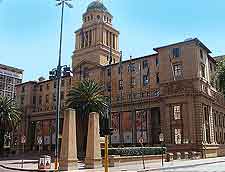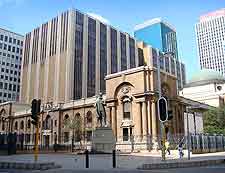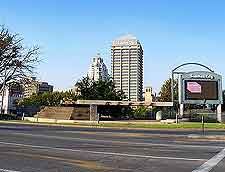Johannesburg Neighbourhoods, Locations and Districts
(Johannesburg, Gauteng, South Africa)

Johannesburg sprawls over a vast area. Divided into districts, however, it's relatively easy to navigate. Each neighbourhood is very different in character and atmosphere. It's worth noting that in recent years, there has been something of an exodus of businesses away from the city centre district and to locations in the suburbs to the north of Johannesburg.
Rising crime levels in the city centre districts have led to visitors being advised to take care when visiting attractions in that area, although only sensible precautions are really necessary.

City Centre
Skyscrapers jostle for attention in Johannesburg's city centre district of Newtown. During the day, the city streets are crowded with workers rushing to and from their offices, while during the evening, the neighbourhood becomes something of a ghost town. Newtown and nearby Braamfontein form two ends of the city's Cultural Arch. Indeed, many noteworthy visitor attractions can be found within Newtown Cultural Precinct. Hillbrow and Berea on the other hand, are fairly run-down residential districts and visitors are advised against exploring them on their own.
Soweto
Situated to the south-west of Johannesburg city centre, Soweto (or to give the district its full name, 'South Western Townships') is a massive community. In recent years, the township has seen many changes, with the addition of shopping centres, wealthy estates and tourist attractions to the cardboard and tin shacks that have characterized the area for many years.

Sandton District
Sandton has grown tremendously over the past few years. Today, the district is crammed full of hotels, clubs, restaurants and shops. It also has a large wealthy residential population, with gated communities becoming increasingly popular. For some visitors, this neighbourhood lacks the atmosphere that can be found in Johannesburg's less-developed suburbs.
Eastern Suburbs
Johannesburg's eastern districts are not nearly as popular with visitors as their northern counterparts. Neighbourhoods include Yeoville, Observatory, Troyville and Bez Valley. Cyrildene is notable as city's very own version of Chinatown and is the home to several good authentic Chinese restaurants and supermarkets.
Northern Suburbs
The relocation of much of Johannesburg's financial sector to the northern suburbs has led to a large number of new developments in the past few years. These include new shopping centres, hotels and restaurants. The northern suburbs of Parktown, Killarney and Hyde Park are all fairly wealthy neighbourhoods. Parktown's architecture harks back to its mining origins. Rosebank is recommended for keen shoppers. Melrose is a leafy suburb that offers pleasant accommodation and restaurants. Houghton is an interesting neighbourhood, mainly because it's here that Nelson Mandela often stays when he's in town.
North-Western Suburbs
The north-western suburb of Melville is seen as the creative capital of Johannesburg. Its residents include a mix of artists and actors, as well as film makers and university lecturers. As you'd expect, the neighbourhood is home to many lively restaurants and bars, and its coffee shops are definitely the place to see and be seen. Greenside and Parkhurst are also good neighbourhoods for dining out and shopping.
 Johannesburg sprawls over a vast area. Divided into districts, however, it's relatively easy to navigate. Each neighbourhood is very different in character and atmosphere. It's worth noting that in recent years, there has been something of an exodus of businesses away from the city centre district and to locations in the suburbs to the north of Johannesburg.
Johannesburg sprawls over a vast area. Divided into districts, however, it's relatively easy to navigate. Each neighbourhood is very different in character and atmosphere. It's worth noting that in recent years, there has been something of an exodus of businesses away from the city centre district and to locations in the suburbs to the north of Johannesburg.
